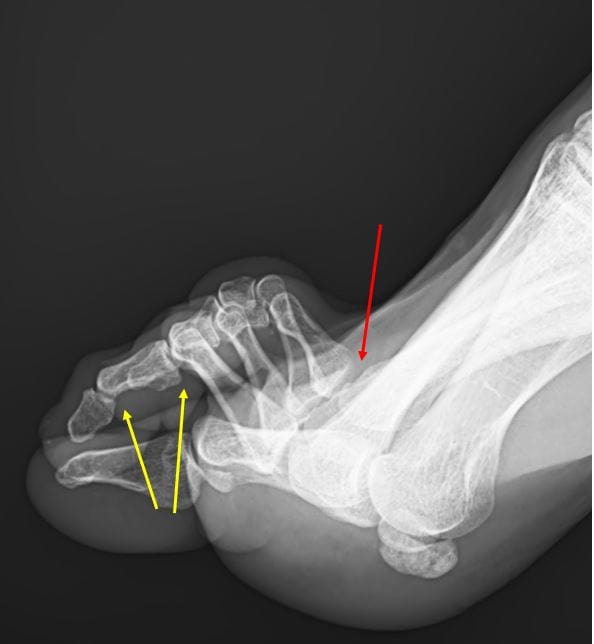Published on
Differential Diagnosis
- Claw toe deformity
- Hammer toe
- Inflammatory arthritis
- Mallet toe

Diagnosis
The image shows dorsiflexion of the metatarsophalangeal joints (red arrow) and plantar flexion of the proximal and distal interphalangeal joints (yellow arrows). This patient was diagnosed with claw toe deformities in digits 2 through 5.
Learnings/What to Look for
- Claw toe deformity is a lesser toe deformity characterized by metatarsophalangeal (MTP) dorsiflexion and proximal interphalangeal (PIP) and distal interphalangeal (DIP) plantar flexion
- Claw toe is less common and more severe than hammertoe, which is characterized by PIP dorsiflexion and slight plantar flexion of the MTP and DIP
- Synovitis is the most common cause of claw toe deformity. Other causes include trauma and delayed or missed compartment syndrome involving the deep posterior compartment of the leg or foot
- Associated conditions include cavus deformity, neuromuscular disease affecting intrinsic and extrinsic muscle balance, and inflammatory arthropathies
- Clawing of all four lesser toes implicates a neurologic abnormality
Pearls for Urgent Care Management
- Nonsurgical or surgical treatment is appropriate for claw toe deformity, depending on severity and stage (early or late)
- Nonsurgical management includes wearing arch supports or shoe inserts; exercises to strengthen and stretch muscles in the toes; splinting or taping toes to reinforce proper anatomy; and counseling the patient to avoid high heels and tight shoes
- Severe or late-stage claw toe deformity may require surgery to lengthen and reroute tendons or shorten the phalanx bones. Other surgical options include to fusion or temporary placement of a pin to hold the toe in the correct position
Acknowledgment: Images and case provided by Experity Teleradiology (www.experity health.com/teleradiology.)
View More Articles on Foot Pain
- A Runner With A History Of Foot Pain
- Top 5 Common Causes—And Controversial Conducts—Of Heel Pain In Urgent Care
- Reoccurring Metatarsophalangeal Joint Pain
A 22-Year-Old with Chronic Foot Pain
1 2
